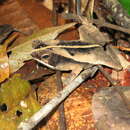Description
(
Inglês
)
fornecido por AmphibiaWeb articles
A medium sized species of the Bufo (Rhinella) margaritifera species group. (1) SVL of females 43.7 +/- 0.8 mm, of males 34.6 +/- 4.3 mm; (2) bony knob at angle of jaws absent, corner of mouth angular; (3) canthus rostralis smooth, concave laterally, without crests; (4) heel not reaching posterior margin of eye when hindlimbs adpressed; (5) cephalic crests low; (6) neural spines indistinct; (7) tympanum large but smaller than eye diameter, round in males, ovoid in females; (8) parotoid glands relatively small, elongated posteriorly; (9) upper eyelid without projections; (10) toes about three-quarters webbed, three phalanges free on toe 4; (11) tarsal fold absent; (12) skin densely tuberculate, particularly on limbs, less between eyes and center of back in females; tubercules conical with small keratinized spicules; (13) oblique row of tubercules present from posterior corner of parotoid glands to groin; (14) snout pointed with fleshy soft ridge extending to tip of snout; (15) iris golden.This species is highly polymorphic. The coloration of the back can be uniformly brown to light gray, or with a variety of leaf-like patterns with successive shades of dark to light brown or gray. A whitish mid-dorsal stripe can occur and can be very thin to 5 mm wide. Flanks are generally darker than the back.
Distribution and Habitat
(
Inglês
)
fornecido por AmphibiaWeb articles
Primary forest of French Guiana. Probably occurring in Suriname and Brazil Amapa as well. Localities range from 20 to 170 m above sea level.
Life History, Abundance, Activity, and Special Behaviors
(
Inglês
)
fornecido por AmphibiaWeb articles
During the rainy season (from November to January and from March to May), males call during daytime within 10 m of slowly running water. Calling males are usually isolated from each other and perched between 0.3 and 1 m high on a vine, dead trunk or root. The calls are long (several seconds) and composed of very short pulse groups that last for 30 ms. Pulse groups are spaced out by 97.2 ms and comprise 4.8 pulses / group on average. The peak frequency is 1.16 kHz and the pulses last 3.45 ms on average. Amplexus is axillary. This species is likely not abundant.

